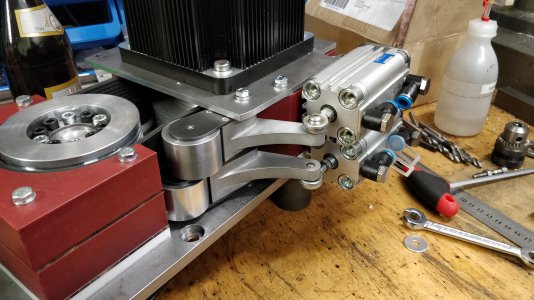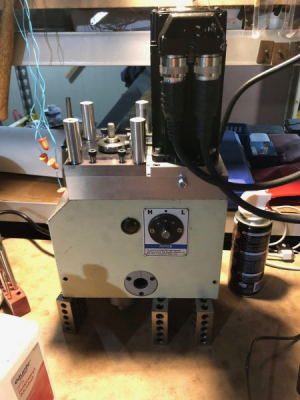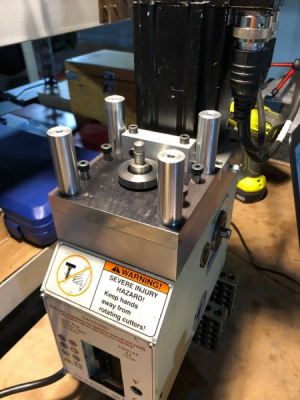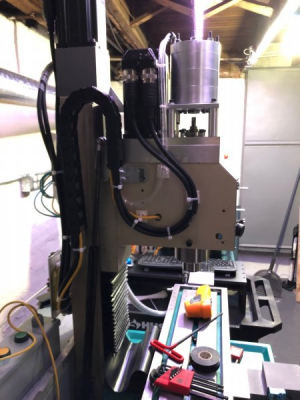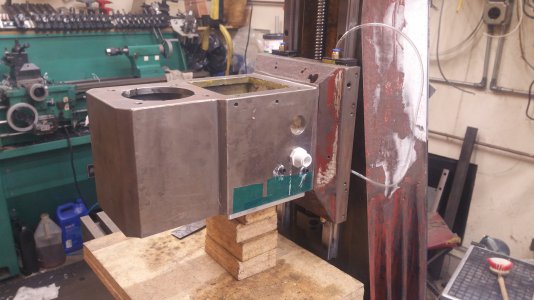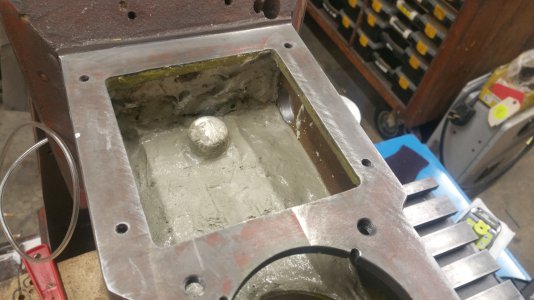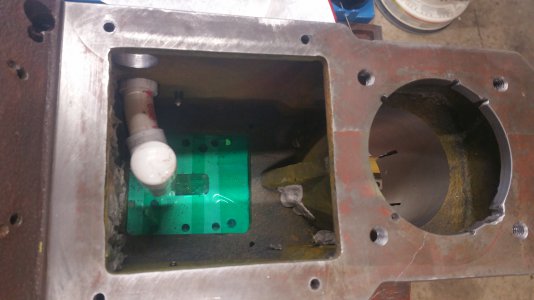- Joined
- Mar 26, 2018
- Messages
- 2,724
Hi All,
I have owned a CNC converted G0704 for about 9 years now and really have a ton of hours on it. One of the things I really enjoy thinking about and have done some experimenting with is understanding how to overcome the significant limitations of these smaller machines by selecting toolpaths and strategies to take advantage of what the machine is good at and avoid what it is not.
Currently my G0704 has a 5000 rpm (11.1Nm of torque), 1.8kW servo spindle and 750W direct drive axis motors for a max rapid of 1000ipm. The tool holding system is the Tormach Tooling System (TTS). I have monitoring of spindle load and axis thrust forces in real time by pulling data from my servo drives which I will use in analysis below. My spindle belt drive consumes 8% of the spindle load in heat, for a total spindle efficiency of 92% (actually pretty good) and 144W of heat generated in the motor, belts, and bearings.
Analysis: The biggest limitation of these machines in rigidity. Toolpaths need to be chosen to minimize horizontal thrust forces while still maximizing material removal. The first approach is to use smaller tools. For my size machine, I find optimum performance with 3/8" endmills in aluminum and 1/4" in steel. I can use larger, but the chipload needs to be less so there is actually a loss of efficiency. Second approach is to use very sharp tools. High polish aluminum specific endmills like the YG-1 Alu-Power are great for pulling more productivity from your machine without needing to upgrade mechanics.
Now the use of smaller tools drives us towards the conclusion that the 2000-2500rpm spindles that come stock on these machines are not suited for CNC operation. As the tool gets smaller, the RPM required to maintain an acceptable surface footage at the tool goes up. I run my spindle maxed out at 5000rpm most of the time and have considered many times over to modify it to reach 10k RPM. For general machining in aluminum (usually pretty light), my spindle load sits below 15%. At 1/4" diameter endmills (aluminum) and 3/16" (steel) and below, I lack the spindle speed to make efficient use of the tool. The heaviest cut I have ever seen this machine take was 1400W in aluminum with a 3/8" endmill and I doubt I would want to do that often without a serious flood coolant setup and enclosure.
There are a few cases where I do start to utilize the torque of the spindle. These are usually in low speed (<800 RPM) roughing operations in cast iron using 1/2" tools. I can maintain about 75-80% torque utilization without having the machine flex all over the place. I also see these higher torque values when drilling with larger drills. Interestingly drilling is great for low rigidity machines (think of drill presses) since all the force is in line with the spindle.
If I were to re-address the spindle situation, I would want a 2 speed belt driven solution with a lower gear to 2500 rpm and a high gear to 10000 rpm with the same 1.8kW power capacity. I think this is achievable with the kinds of machines we work with and actually comes pretty close to what Tormach has evolved their 770 and 1100 spindles to. If your machining needs are typically light machining in aluminum and steel, then 500W of spindle power up to 5000 rpm would likely cover your needs.
The TTS system has been extremely reliable for me except for long extension endmilling (4"+). The straight shank fails to adequately support the moment loading and extreme chatter and tool pullout is almost always the result.
The 18k RPM water cooled spindles seen on eBay are another option. They have great speed, but lack torque and are limited to a bottom speed of 8000rpm. For this reason, they are an excellent choice for milling and routing in aluminum with 3/16", 1/8", or smaller tools. It is actually difficult to mill steel with these as the speed is usually too high and the torque too low.
What about axis feed motors? Truth be told is I have never used 1000ipm beyond initial testing. I limit it to 300ipm and that is still more than needed. The biggest time saver in a CNC for anything we will use it for is the axis accelerations. This means a high torque motor (and low inductance in stepper motors). Milling feed rates up to 80-120ipm will cover pretty much anything you will be doing on a hobby machine.
Going back to how to make the most of the machine you have is utilizing trochoidal "high efficiency" toolpaths. These minimize radial engagement of the cutter and peel away at the work. The axis motors will be under constant acceleration and deceleration so maximizing what your machine can do in that regard will allow you to spend more time at the programmed cutting feedrate. Since our machines are limited in rigidity, we cannot take high chipload cuts, often less than the minimum recommended chip load of the tool. For this reason, it is often advantageous to use endmills with higher flute counts, even 6 or 8 flutes in steels to give higher material removal at a given chip load.
Finally, one strategy I would like to investigate is feedmilling. In this case a special tool is rotated relatively slowly while being fed at extreme feedrates. The resultant forces are pointed into the spindle much like drilling, while remaining extremely efficient in terms of spindle usage and material removal. Unfortunately these tools are uncommon and expensive.
Would love to hear the thoughts from other CNCers
-Mike
I have owned a CNC converted G0704 for about 9 years now and really have a ton of hours on it. One of the things I really enjoy thinking about and have done some experimenting with is understanding how to overcome the significant limitations of these smaller machines by selecting toolpaths and strategies to take advantage of what the machine is good at and avoid what it is not.
Currently my G0704 has a 5000 rpm (11.1Nm of torque), 1.8kW servo spindle and 750W direct drive axis motors for a max rapid of 1000ipm. The tool holding system is the Tormach Tooling System (TTS). I have monitoring of spindle load and axis thrust forces in real time by pulling data from my servo drives which I will use in analysis below. My spindle belt drive consumes 8% of the spindle load in heat, for a total spindle efficiency of 92% (actually pretty good) and 144W of heat generated in the motor, belts, and bearings.
Analysis: The biggest limitation of these machines in rigidity. Toolpaths need to be chosen to minimize horizontal thrust forces while still maximizing material removal. The first approach is to use smaller tools. For my size machine, I find optimum performance with 3/8" endmills in aluminum and 1/4" in steel. I can use larger, but the chipload needs to be less so there is actually a loss of efficiency. Second approach is to use very sharp tools. High polish aluminum specific endmills like the YG-1 Alu-Power are great for pulling more productivity from your machine without needing to upgrade mechanics.
Now the use of smaller tools drives us towards the conclusion that the 2000-2500rpm spindles that come stock on these machines are not suited for CNC operation. As the tool gets smaller, the RPM required to maintain an acceptable surface footage at the tool goes up. I run my spindle maxed out at 5000rpm most of the time and have considered many times over to modify it to reach 10k RPM. For general machining in aluminum (usually pretty light), my spindle load sits below 15%. At 1/4" diameter endmills (aluminum) and 3/16" (steel) and below, I lack the spindle speed to make efficient use of the tool. The heaviest cut I have ever seen this machine take was 1400W in aluminum with a 3/8" endmill and I doubt I would want to do that often without a serious flood coolant setup and enclosure.
There are a few cases where I do start to utilize the torque of the spindle. These are usually in low speed (<800 RPM) roughing operations in cast iron using 1/2" tools. I can maintain about 75-80% torque utilization without having the machine flex all over the place. I also see these higher torque values when drilling with larger drills. Interestingly drilling is great for low rigidity machines (think of drill presses) since all the force is in line with the spindle.
If I were to re-address the spindle situation, I would want a 2 speed belt driven solution with a lower gear to 2500 rpm and a high gear to 10000 rpm with the same 1.8kW power capacity. I think this is achievable with the kinds of machines we work with and actually comes pretty close to what Tormach has evolved their 770 and 1100 spindles to. If your machining needs are typically light machining in aluminum and steel, then 500W of spindle power up to 5000 rpm would likely cover your needs.
The TTS system has been extremely reliable for me except for long extension endmilling (4"+). The straight shank fails to adequately support the moment loading and extreme chatter and tool pullout is almost always the result.
The 18k RPM water cooled spindles seen on eBay are another option. They have great speed, but lack torque and are limited to a bottom speed of 8000rpm. For this reason, they are an excellent choice for milling and routing in aluminum with 3/16", 1/8", or smaller tools. It is actually difficult to mill steel with these as the speed is usually too high and the torque too low.
What about axis feed motors? Truth be told is I have never used 1000ipm beyond initial testing. I limit it to 300ipm and that is still more than needed. The biggest time saver in a CNC for anything we will use it for is the axis accelerations. This means a high torque motor (and low inductance in stepper motors). Milling feed rates up to 80-120ipm will cover pretty much anything you will be doing on a hobby machine.
Going back to how to make the most of the machine you have is utilizing trochoidal "high efficiency" toolpaths. These minimize radial engagement of the cutter and peel away at the work. The axis motors will be under constant acceleration and deceleration so maximizing what your machine can do in that regard will allow you to spend more time at the programmed cutting feedrate. Since our machines are limited in rigidity, we cannot take high chipload cuts, often less than the minimum recommended chip load of the tool. For this reason, it is often advantageous to use endmills with higher flute counts, even 6 or 8 flutes in steels to give higher material removal at a given chip load.
Finally, one strategy I would like to investigate is feedmilling. In this case a special tool is rotated relatively slowly while being fed at extreme feedrates. The resultant forces are pointed into the spindle much like drilling, while remaining extremely efficient in terms of spindle usage and material removal. Unfortunately these tools are uncommon and expensive.
Would love to hear the thoughts from other CNCers
-Mike


